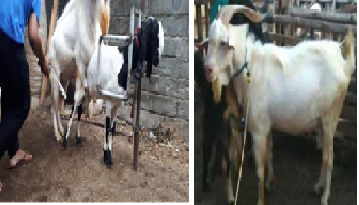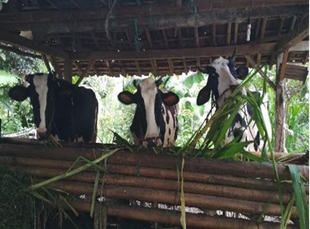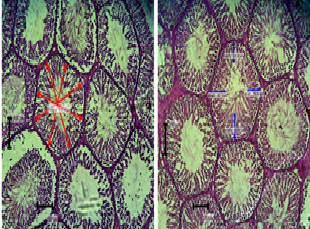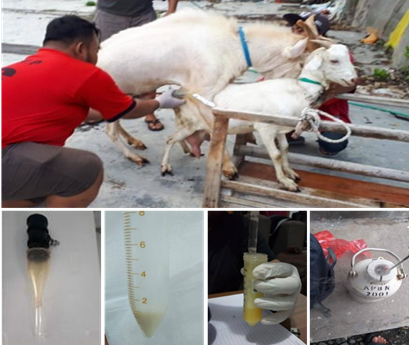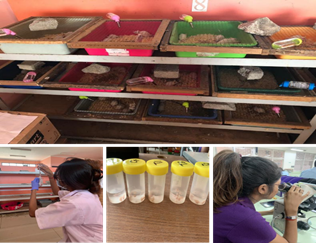Calf morbidity and mortality rates Associated risk factors in smallholder dairy farms in Kembata Tembaro zone, Southern Ethiopia

Downloads
A study was carried out in the Kembata Tembaro Zone of Southern Ethiopia, focusing on both prospective cohort and cross-sectional surveys. The objective was to measure the rates of calf sickness and death and to pinpoint the factors that contribute to these conditions. Over 180 days, 140 newborn calves from selected small-scale dairy farms were studied. The study evaluated the prevalence of illness, mortality, and specific diseases by calculating incidence rates. Results indicated a 41.7% risk of illness and a 9.5% mortality rate among calves. Factors such as the calf's condition at birth, birth location/environment, the surface on which the calf was born, timing of the first colostrum intake, maternal parity, calf breed, and the breeding service technique significantly influenced mortality rates. Similarly, these factors were also significantly linked to the crude morbidity rate. Calves born naturally were at a lower risk of sickness (HR=0.6, p=0.001) compared to those assisted. Calves born indoors had a lower risk of sickness (HR=0.9, p=0.008) than those born outdoors. Calves that received colostrum within six hours of birth had a lower risk of sickness (HR=0.6, p=0.009) than those that received it later. Additionally, the study found that the floor of the birth place, the mother's parity, the breed of the calf, and the technique of the breeding service were additional risk factors for calf sickness. The time of the first colostrum intake, the mother's parity, and the calf's birth condition were also significant risk factors for calf death.
Ababu D, Workneh A, Hedge P. 2006. Performance of the Abernosa ranch in the production of Ethiopian Boran X Holstein crossbreed dairy heifers in Ethiopia. Ethiop J Anim Prod. 6: 33-53.
Agegnehu MB, Rahmeto A. 2020. Prospective longitudinal study of calf morbidity and mortality in urban and peri-urban dairy farms at and around Hawassa city. Glob Vet. 22: 247.
Amuamuta A, Asseged B, Goshu G. 2006. Mortality analysis of Fogera calves and their Friesian crosses in Andassa cattle breeding and improvement ranch, Northwestern Ethiopia. Revue Méd Vét. 157: 525-29.
Assefa A, Ashenafi K. 2016. Dairy calf morbidity and mortality and associated risk factors in Sodo town and its suburbs, Wolaita zone, Ethiopia. J Anim Sci. 49: 44-56.
Bekele M, Abduba Y, Alemayehu R. 2009. Prevalence and incidence rates of calf morbidity and mortality and associated risk factors in smallholder dairy farms in Hawassa, Southern Ethiopia. Ethiop Vet J. 13: 59-68.
Dohoo IR, Martin SW, Stryhn H. 2009. Veterinary epidemiologic research, AVC Inc., Charlottetown, University of Prince Edward Island, Charlotte town, Canada.
Donovan GA, Dohoo IR, Montgomery DM, Bennett FL. 1998. Calf and disease factors affecting growth in female Holstein calves in Florida, USA. Prev Vet Med. 33: 1-10.
Esubalew S, Debeb D. 2017. Retrospective study on calf mortality in dairy farms in Gondar town. Int J Adv Res Pub. : 48-54.
Gebremedihin R. 2014. Major causes of calf mortality in intensive dairy farms, Central Ethiopia. Int J Livest Res. 4: 9-16.
Gitau GK, McDermott JJ, Waltner-Toews D, Lissemore KD, Osumo JO, Muriuki D. 2012. Factors influencing calf morbidity and mortality in smallholder dairy farms of Kiambu District, Kenya. Prev Vet Med. 21: 167-78.
Godden S. 2008. Colostrum management for dairy calves. Vet Clin North Am Food Anim Pract. 24: 19-39.
Goshu G, Singh H. 2013. Lactation specific and life time demographic parameters in a Holstein Friesian herd in the central highlands of Ethiopia. Livest Res Rural Dev. 25: 200.
Heinrichs AJ, Radostits OM. 2001. Health and production management of dairy calves and replacement heifers. In: Radostits OM (Ed). Herd health, food animal production medicine. 3th Ed. WB Saunders Company, USA. 333-95.
Kembata Tembaro zone Livestock department. 2021. Kembata Tembaro zone Livestock department annual report.
Kevin JC, Lorin DR, Julie DS, Emily MW, Yrjo TG, Martin W. 2010. Salmonella enteric serotype among dairy cattle in New York: an emerging pathogen? Foodborne pathog dis. 7: 659-65.
Keyyu JD, Kyvsgaard NC, Monrad J, Kassuku AA. 2005. Epidemiology of gastrointestinal nematodes in cattle on traditional, small-scale dairy and large-scale dairy farms in Iringa district, Tanzania. Vet Parasitol. 127: 285-94.
Lindsay L. 2012. Morbidity and mortality rates based on stress levels in dairy calves. BSc Thesis. California Polytechnic State University. California, USA.
Lorenz I, Mee JF, Early B, More SJ. 2011. Calf health from birth to weaning. General aspects of disease prevention. Ir Vet J. 64: 10.
Martin SW, Meek AH, Willeberg P. 2007. Veterinary epidemiology: Principle and methods. Iowa, Iowa state University Press. Iowa, US.
Mee JF. 2013. Why do so many calves die on modern dairy farms and what can we do about calf welfare in the future? Animals (Basel) 3: 1036-57.
Mekonnen H, Asmamaw K, Courreau JF. 2006. Husbandry practices and health in smallholder dairy farms near Addis Ababa, Ethiopia. Prev Vet Med. 74: 99-107.
Mellado M, Lopez E, Veliz FG, De Santiago MA, Macias-Cruz U, Avendaño-Reyes L, Garcia JE. 2014. Factors associated with neonatal dairy calf mortality in a hot-arid environment. Livest Sci. 159: 149-55.
Mengesha K, Gurmu EB, Hussein D. 2013. Major management and health problems of calves in dairy farms in and around Mekelle. Rev Electron Vet. 14: 109356004.
Ministry of Agriculture. 2014. Livestock master plan: Roadmaps for growth and transformation. Livestock development sector, Addis Ababa, Ethiopia.
Moran JB. 2011. Factors affecting high mortality rates of dairy replacement calves and heifers in the tropics and strategies for their reduction. J Anim Sci. 24: 1318-28. https://doi.org/10.5713/ajas. 2011.11099
Muraguri GR, McLeod A, McDermott JJ, Taylor N. 2005. The incidence of calf morbidity and mortality due to vector-borne infections in smallholder dairy farms in Kwale District, Kenya. Vet Parasitol. 130: 305-15.
Negassa A, Rashid S, Gebremedhin B. 2011. Livestock production and marketing ESSP II, Working Paper. International Food Policy Research Institute.
Shiferaw Y, Yohannes A, Yilma Y, Gebrewold A, Gojjam Y. 2002. Dairy husbandry and health management at Holleta. Proceeding of the 16th conference of the Ethiopian Veterinary Association. Addis Ababa, Ethiopia. 103-19.
Swai ES, Karimuribo ED, Kambarage DMR. 2010. Risk factors for smallholder dairy cattle mortality in Tanzania. J S Afr Vet Assoc. 81: 241-6.
Tegegne A, Gebrewold A. 1998. Prospects for peri-urban dairy development in Ethiopia. Proceeding of 5th conference of Ethiopian society of animal science (ESAP). 15-17 May 1997. Addis Ababa, Ethiopia.
Tekalign WU. 2020. Calf health and management practices in small holder dairy farms in and around Wolaita Sodo town, Ethiopia. Int J Adv Res Biol Sci. 96: 1-16.
Tewodros B. 2008. Assessment of productive and reproductive performance of indigenous and crossbreed cattle under smallholder management system in North Gondar, Amhara region. M.Sc. Thesis. Mekelle University, Ethiopia.
Tora E, Abayneh E, Seyoum W, Shurbe M. 2021. Longitudinal study of calf morbidity and mortality on smallholder farms in southern Ethiopia. PLoS One 16: e0257139.
Tsegaw F, Wudu T, Achenef M, Getachew A, Shimelis F. 2016. Assessment of young stock mortality in major livestock production systems of Ethiopia. Feed the Future. Research Award.
Varma JK, Greene KD, Ovitt J, Barrett TJ, Medalla, F, Angulo FG. 2005. Hospitalization and antimicrobial resistance in Salmonella outbreaks, 1984-2002. Emerg Infect Dis. 11: 943-6.
Wudu T. 2004. Calf mortality and morbidity in Debrezeit and its environs. M.Sc. thesis. Addis Ababa University. Debre Zeit, Ethiopia.
Wudu T, Kelay B, Mekonnen HM, Tesfu K. 2008. Calf morbidity and mortality in smallholder dairy farms in Ada'a Liben district of Oromia, Ethiopia. Trop Anim Health Prod. 40: 369-76.
Yahya AKH, Tetraifl MEL, Siddig FS. 2011. Performance of Kenana x Friesian cross-bred cattle in Central Sudan. Online J Anim Feed Res. 6: 274-9.
Yeshwas F. 2015. Epidemiological determinants and magnitude of calf morbidity and mortality in Bahir Dar milk-shed, North West Ethiopia. A repository of agriculture research output. M.Sc. thesis. Addis Ababa University. Debre Zeit, Ethiopia.
Yeshwas F, Hailu M, Tewodros B. 2014. Pre-weaning morbidity and mortality of crossbred calves in Bahir Dar Zuria and Gozamen districts of Amhara region, Northwest Ethiopia. Sci Res. 1: 1-8.
Copyright (c) 2024 Teshome Yohannes, Tariku Geinoro

This work is licensed under a Creative Commons Attribution-ShareAlike 4.0 International License.
Ovozoa by Unair is licensed under a Creative Commons Attribution-ShareAlike 4.0 International License.
1. The journal allows the author to hold the copyright of the article without restrictions.
2. The journal allows the author(s) to retain publishing rights without restrictions
3. The legal formal aspect of journal publication accessibility refers to Creative Commons Attribution Share-Alike (CC BY-SA).
4. The Creative Commons Attribution Share-Alike (CC BY-SA) license allows re-distribution and re-use of a licensed work on the conditions that the creator is appropriately credited and that any derivative work is made available under "the same, similar or a compatible license”. Other than the conditions mentioned above, the editorial board is not responsible for copyright violation.





























